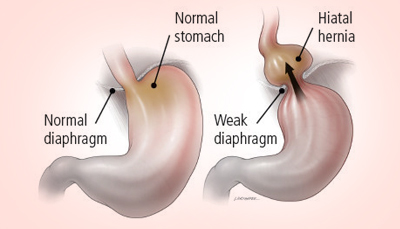
Hiatal hernia is a condition that affects many individuals, yet it often goes undiagnosed. Understanding this common but frequently overlooked medical issue is crucial for improving public health and ensuring timely treatment. As a healthcare professional, I aim to shed light on this condition, its symptoms, and the effective treatment options available.

A hiatal hernia occurs when a part of the stomach pushes up into the chest through an opening in the diaphragm called the hiatus. The diaphragm is a large muscle that separates the chest cavity from the abdominal cavity and plays a key role in breathing. The esophagus, the tube that carries food from the mouth to the stomach, passes through this opening. When the stomach protrudes through the hiatus, it is known as a hiatal hernia.
There are two primary types of hiatal hernias:
1. Sliding Hernia: This is the most common type, where the stomach and the lower part of the esophagus slide up into the chest cavity.
2. Paraesophageal Hernia: Less common but more serious, this type occurs when a part of the stomach pushes through the diaphragm and sits beside the esophagus, which can lead to complications like twisting of the stomach or strangulation.

Many individuals with a hiatal hernia may not experience any symptoms. However, when symptoms do occur, they can include:
- Heartburn or a burning sensation in the chest
- Regurgitation of food or liquids into the mouth
- Acid reflux
- Difficulty swallowing
- Chest or abdominal pain
- Shortness of breath
- Vomiting blood or passing black stools, which may indicate gastrointestinal bleeding
The symptoms of a hiatal hernia often mimic those of other conditions, such as acid reflux or gastroesophageal reflux disease (GERD), making it difficult to diagnose. Many people dismiss their symptoms as minor digestive issues, not realizing they could be signs of a more significant problem.
Diagnosis typically involves imaging tests such as X-rays or endoscopy. An endoscopy is a procedure where a thin, flexible tube with a camera is inserted through the mouth to examine the esophagus and stomach. These tests can help confirm the presence and type of hiatal hernia.

Treatment for a hiatal hernia depends on the severity of the condition and the symptoms. For many people, lifestyle changes and medications to reduce stomach acid can effectively manage symptoms. These medications include antacids, H2-receptor blockers, and proton pump inhibitors.
In more severe cases, especially with paraesophageal hernias, surgery may be necessary. Surgical treatment involves repositioning the stomach and repairing the diaphragm opening to prevent recurrence. Minimally invasive techniques, such as laparoscopic surgery, offer high success rates and quicker recovery times.
Hiatal hernia is a common condition that often goes undiagnosed due to its subtle symptoms. However, with proper diagnosis and treatment, individuals can achieve significant relief and improve their quality of life. If you experience persistent symptoms such as heartburn, chest pain, or difficulty swallowing, it is important to consult a healthcare provider for a thorough evaluation.
Early diagnosis and appropriate treatment can lead to excellent outcomes. Don’t ignore your symptoms—take the first step towards better health today.

